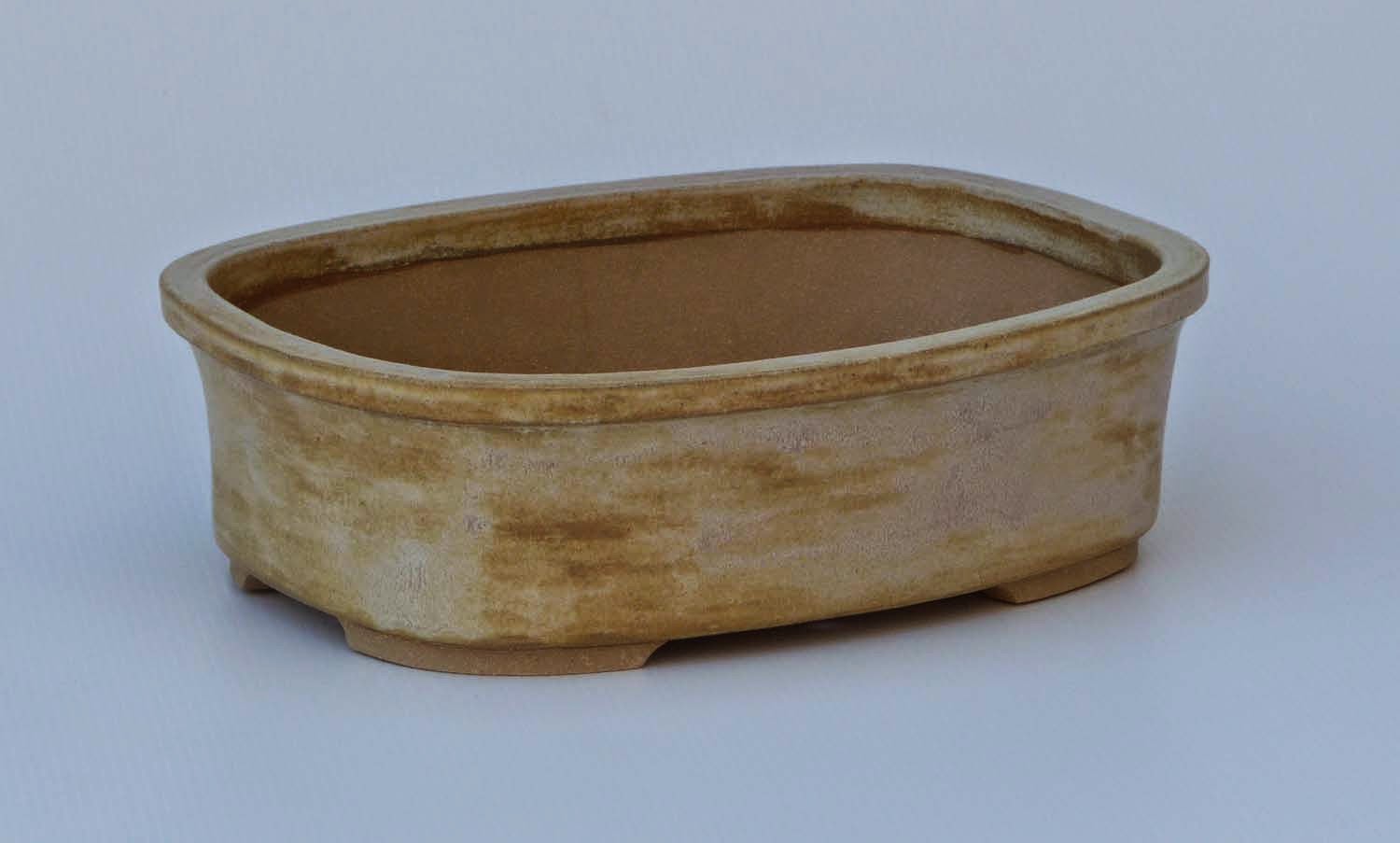I had a request to make a rectangular pot 'like Pot No 38' which I made in February 2013 . It had a length of about 360mm and was 79mm high.
The requested pot was just a bit longer and a bit higher, but with the same glaze colouring and effect. Well easier said than done when the colouration is principally achieved by the different depth of application of the glaze to give the patinated mottled look. I keep careful records of glaze recipes I use on which pot but as to the detail of how I apply them well that's a different matter.
I'm not keen on making rectangular pots because of the risk of deformation which is less likely and less apparent where the walls have some curvature. The making of a rectangular pot is best accomplished by using slab formed clay which has dried flat to a point of inflexibility and is only moved by board flipping. By doing this the only memory the clay has is of being flat and straight. The drier the clay of course the higher the risk of joint failure and the more care needs to be taken. Also the thickness of the clay on the corners needs to be uniform and consistent with the walls so that there is little differential contraction at the corner to promote bowing. All this takes more time and carries greater risk which is why all makers charge more for rectangular pots than other shapes.
Despite all that I've done pretty well on the colour match. One wall has a little bow but that is one of those wabi-sabi atefacts of a hand made pot and will be invisible to the eye in use.
Post 153 in June was about glaze crawling on a large oval pot. The next pot, Pot No 121, is its replacement in a slightly different glaze formulation, still a high gloss dark blue.
Pot No 114 is a rectangular pot fired with a mottled mid brown glaze.
The requested pot was just a bit longer and a bit higher, but with the same glaze colouring and effect. Well easier said than done when the colouration is principally achieved by the different depth of application of the glaze to give the patinated mottled look. I keep careful records of glaze recipes I use on which pot but as to the detail of how I apply them well that's a different matter.
I'm not keen on making rectangular pots because of the risk of deformation which is less likely and less apparent where the walls have some curvature. The making of a rectangular pot is best accomplished by using slab formed clay which has dried flat to a point of inflexibility and is only moved by board flipping. By doing this the only memory the clay has is of being flat and straight. The drier the clay of course the higher the risk of joint failure and the more care needs to be taken. Also the thickness of the clay on the corners needs to be uniform and consistent with the walls so that there is little differential contraction at the corner to promote bowing. All this takes more time and carries greater risk which is why all makers charge more for rectangular pots than other shapes.
Despite all that I've done pretty well on the colour match. One wall has a little bow but that is one of those wabi-sabi atefacts of a hand made pot and will be invisible to the eye in use.
Pot No 122 Rectangular at 373mm x 281mm x 85mm
Post 153 in June was about glaze crawling on a large oval pot. The next pot, Pot No 121, is its replacement in a slightly different glaze formulation, still a high gloss dark blue.
Pot No 121 Oval at 470mm x 342mm x 88mm
Pot No 121 overview
Pot No 121 Glaze detail
The next one, Pot No 111 is a nice little oval pot in a pale blue glaze.
Pot No 111 Oval at 273mm x 205mm x 53mm
I made the next two pots to eventually contain a couple of my ceramic tanuki/sergent trees. Because the ceramic tanukis have fairly substiantial base diameters I wanted pots that have a complementary depth. The first one is one of my compound shapes. The glaze has an antique base overglazed with beige. I though it might be darker but this is a fine match for the colour of the 'deadwood'.
Pot No 115 Compound at 270mm x 197mm x 79mm
Pot No 115 Overview
Pot No 114 is a rectangular pot fired with a mottled mid brown glaze.
Pot No 114 Compound at 245mm x 185mm x 78mm
And the last one for this firing is a Shohin, Pot S38. It is a bowed wall rectangular pot with a rounded flange and lower wall rib. The glaze is the same dual combo as Pot No 115.
Shohin S38 at 176mm x 133mm x 53mm









No comments:
Post a Comment
Happy to hear your advice, feedback or questions